IMDB metadata: 1 hour and 17 minutes at 5.9/10 from 817
The Cold War was never hotter than in 1953 with the see-saw Korean War piling up a body count of GIs. Was this but prelude to World War III? A lot of pundits at the time said so every day. Some wanted it to happen, believe it or not. This was the atmosphere in which audiences first saw this movie.
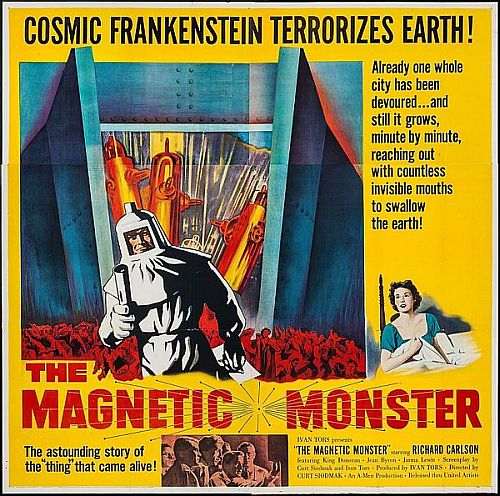 The lobby card implies a creature, one that came alive.
The lobby card implies a creature, one that came alive.
Richard Carlson, ever reliable in B movieland, is sent to investigate strange occurrences at a local store. Voiceovers by Carlson with date and time noted, give it a documentary tone throughout.
Everything in the store is magnetised. Clocks and watches stop. Washing machine doors open and close. Loose change flies up to and adheres on the ceiling. Carlson stokes his chin and decides to go upstairs.
But wait! He and his bespectacled offsider, King Donovan, don radiation suits to do so because the click-click of the Geiger counter is excited. This is noteworthy.
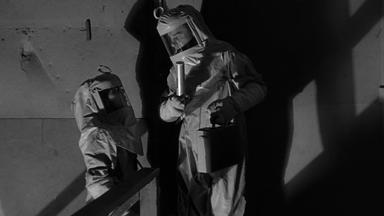
The official line of the Atomic Energy Commission at the time was that radiation was a nuisance. Wash your hands, wear a coat, take an aspirin, and there will be no problem. For an example of this treatment of radiation see ‘The Atomic Man’ (1955), reviewed elsewhere on this blog. In 1953 fears of radiation were denounced by red blooded idiots as Commie fake news to weaken popular support for the development of Made in the USA nukes. There were those who denied the lethal but unseen effects of radiation.
Carlson finds upstairs that an emeritus professor, never to be trusted those types, has created a new element that combines nuclear radiation and magnetism! They also find Igor, dead. Both the element and the prof are gone, though the lingering aftereffects of the element remain virulent. Kind of like after a Twit in Chief speech, a deadly miasma remains.
The police, army, and girl scouts are called into the crisis, says the Carlson in a documentary voiceover. All are shown to be responsive and responsible. Ha! Well it is a work of fiction, so there are no petty bureaucrats obstructing things, no police officer dedicated to coffee drinking, and no soldiers hiding in the motor pool for a smoke. No girl scouts short a cookie or two.
They follow the invisible spoor of the prof’s radiation with Geiger counters aclicking to reassure the public. Big Brain that he is, prof has packed the deadly element in his tattered briefcase with his lunch and taken plane to Washington on the DC to prove to the world that he is no useless emeritus, but a genius. The element disables the airplane and it also kills him. Two dead. More follow.
Again radiation suits proliferate and great care is manifested in taking possession of the deadly element, so unlike most 1950s presentations of uranium, let’s call it that to keep it simple. No one rips off the hazard suit mask for close-ups, as we saw in ‘Arrival’ (2016).
Carlson and company peer through a microfilm reader at lights projected on the wall through the bottom of a Coca-Cola bottle in cutting edge science. The element which is here christened Carlsonium absorbs energy in great gulps and doubles in size every twelve hours. The fraternity brothers are a lot like that: Ingest everything and grow ever larger, but they are peaceable. Not so Carlsonium which sucks and sucks. It sucks!
The bigger it gets, the more it sucks in energy. Not even AAA batteries are safe from it. Lead-lined rooms cannot contain it. More deaths occur.
After thirty minutes of this, Carlson, who must have had a dog, decides to see just how much energy it can eat. He will pump so much energy into it that the resultant indigestion will kill it. Is this a plan or what?
Fortunately he knows just the place to stage this food-orgy (fraternity brothers, that is, ‘food orgy’), Nova Scotia. For generations people have wondered what Nova Scotia was good for and now they know! How quickly people forget, because the Nova Scotia Tourist Commission no longer mentions this event among its claims to fame.
Thanks to some quick typewriting in the screen play, they devise a way to transport the Carlsonium to Nova Scotia. Once there everyone dresses for a 1930s German expressionist film in broad brimmed fedoras and ankle length, tent overcoats. There they find yet another scientist pursing the KPIs of his life in a vast machine that can zap 600,000 watts of electricity at a time. Think of all those light bulbs.
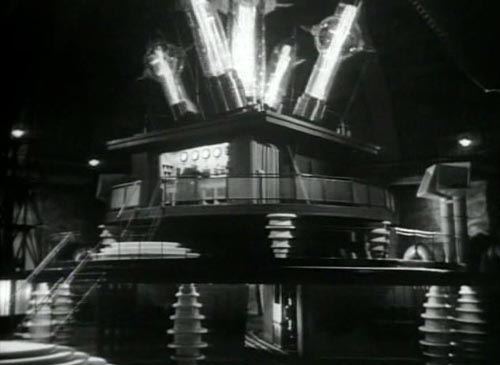 Nova Scotia, Light, and Power
Nova Scotia, Light, and Power
He welcome Carlson as a fellow scientist only to recoil at the plan to blow up the ever enlarging Carlsonium along with his gargantuan machine. Americans only go to Canada when they want something, he thought to himself, but this is too much.
This machine is served by a horde of workers dressed in ‘Metropolis’ (1926) fashions. At one point Carlson puts on a flat soft cap to fit in and then takes it off.
This is the only discord in the film. Fisticuffs result. Guess who prevails. Ka-boom. End.
This third act is mostly cut from an earlier German film, ‘Gold’ (1934). and inserted into this story line. Knowing that to be the case, one can easily see it, though for a naive viewer it might slip by with the pace of the story, which is lively. Robin Bales, always quick to slice and dice a film, when he reviewed this one made no mention of this insertion.
The director and writer was Curt Siodmak.
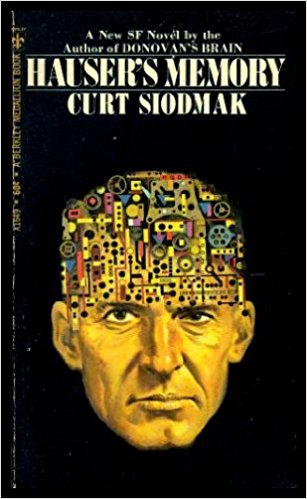
This was the first of producer Ivan Tors’s three films featuring the labours of the Office of Scientific Investigations whose agents, like Carlson in this instance, were styled A-Men, the ‘A’ being for Atomic.
The titular reference to a ‘Magnetic Monster’ puts in the phylum of creature features, but, in fact, there is no creature to this feature. Just a lump of coal. It is inert. Even less energetic than the fungus of ‘Space Master X-7’ (1958), reviewed elsewhere on this blog. The story of this latter film is similar in the pursuit of a carrier of a dangerous element. Though the film at hand has more lively direction, makes some effort at science, and has a more engaging lead than ‘Space Master X-7.’
Author: Michael W Jackson
‘Der Schweigende Stern’ (1960)
IMDB metadata: 1 hour and 33 minutes of Dali time at 4.3/10 from 2197 time wasters.
Based on an early novel by Stanislav Lem, this is a Polish-East German production made at the height of the Cold War.
 Stanislav Lem, the prolific Polish Sy Fy writer. Do not blame him for this mish-mash.
Stanislav Lem, the prolific Polish Sy Fy writer. Do not blame him for this mish-mash.
The original screenplay was, sources say, larded with anti-American pronouncements absent from the novel, and as a result Lem quickly disassociated himself from the project.
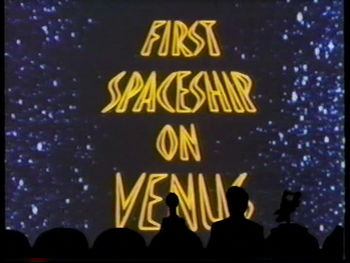
The title above translates as ‘The Silent Star’ but it has been released in several versions, each with a different title. On You Tube it goes by ‘First Spaceship on Venus.’ The edited versions are dubbed and the dubbing is also done in a way to fit the intended audience.
The You Tube version was bought, edited, and dubbed for an American audience at the bottom of a double bill or for the insatiable and indiscriminate drive-in audience. The import of the changes are many.
Set in far distant 1985, an international space program led by the Soviet Union is about to launch the first mission to Mars. The magnificent eight are multi-national, a black African, a Japanese, a Chinese, an Indian, an East German, an Italian red, and a Tom Cruise, and the Russian who is the leader. World peace prevails apart from the petulant ructions of Tom Cruise.
In the many cut and dubbed versions the identities of the Russian and American are reversed, and in France the East German becomes French, in Italy….
In the American version the Russian who has become an American by the magic of dubbing arrives at the assembly point in a Mikoyan-Gurevich MiG-21. Sure they put telephone books on the seat so that Tom Cruise could see.
Assembled, the team mutters platitudes, and just below eye-level Tom Cruise struts.
Meanwhile, in far Eastern Siberia scientists have dug up something from the site of the Tunguska meteor impact of 1908. It is never clearly shown on screen but it is referred to as a wire. This wire has been fabricated, made of elements not of this Earth, and is a recording device. There is an incomprehensible signal on it. Many squiggles are shown on the Moog synthesiser. Meanwhile, the astronomers have gotten their imaginations to work and concluded from the angle of impact that the meteor came from Venus. Sure, after Tom got out of the MIG the astronomers stood on the telephone books and there was Venus. Morning star and all that.
In response to this evidence of an intelligent communication from Venus, the mission is changed from Mars to Venus. Out come the slide rules to chart a new course. Done!
Off they go. There are no tensions among the crew, though one of the crew tries to re-kindle a romance with the Japanese, who in the original has many things to say about the Hiroshima bomb dropped by those horrible Americans. These remarks are omitted in the American version. Oddly enough she does not discuss the Japanese Occupation of China or Korea.
At no time in this 1959 production does one of the men marvel at a woman who is a scientist as unnatural, odd, or against nature. Nor does any of them try to hit on these two women. It is unique in the annals of 1950s Sy Fy to lack sexism. Just the kind of perversion to be expected from the Russkies. They also take along a small robot tank that rolls around doing nothing much.
They land on a murky, dank, dark, gaseous Venus that must have been impressive on the wide screen in 1959 when the original version was released. This Venus is altogether other worldly.
No one is home.
Donning their credible spacesuits, they wander around using up fuel and oxygen until they stumble on to some feral USB sticks in the shape of small Northern Territory blowflies. They find a giant golf ball into which they plug the USB flies and set about learning Venusian, which is similar to Venetian so the Italian in the crew quickly masters it.
The ‘Ah ha’ moment arrives. The signal on the wire in the tundra was targeting data for a Big Bertha energy weapon on Venus. The aim was to blast Earth. Why? Because it is there.
Ever the peril with low bid contractors, Big Energy Bertha failed and the backfire depopulated Venus in one big bang, that no Earth astronomer noticed. What were they doing to miss this? We’ll never know.
There are some striking images of humanoid figures burned onto walls like some in Hiroshima from that atomic blast. This sight unhinges the Japanese woman. The design, art work, and travelling mattes were very well done on Venus.
The Venusians died to the last before they could safely eject all the peripherals from the big, old iMac golf ball. All the nosing around by the crew has awakened the equipment which starts an ominous IOS update and by some blink of the eye we are are transported to Yellowstone National Park, home of boiling mud, some coloured but most black. This sludge is enveloping everything. Not good.
They skedaddle but in the confusion the noble American (Russian) sacrifices himself to save others. Can any one picture that midget ego doing that? No? Moving on. Two others also get killed. The remaining change the D batteries and return home. They declare the mission a success. Sure. Why not.
They have learned that blowing yourself up is bad. Very bad. Don’t do it. No. Lesson learned. Moral: blow up others, not yourself.
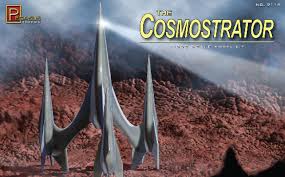 The Cosmostrator later did duty on Liberace’s piano.
The Cosmostrator later did duty on Liberace’s piano.
Pedantic note. Venus is a planet, not a star. It does not twinkle, as twinkle, twinkle little star. It is silent in that, since everyone is dead, no return phone calls.
Four books, three good, one not.
‘The Nine-Tailed Fox’ (2017) and ‘Pong Pong Heart’ (2015) by Martin Limón
Entries in this reliable series following the (mis)adventures of George Sueño and Ernie Bascom, Criminal Investigators, 8th Army Headquarters, Seoul, South Korea circa 1972. In earlier reviews descriptions of the two protagonists and their world have been outlined elsewhere on this blog. Go there for background.
Suffice to say here, that these entries maintains the standard of the earlier titles.
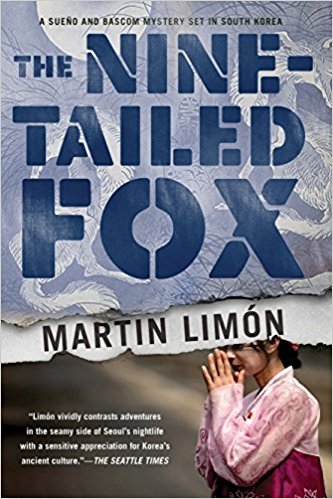

There are many things to like about these books. First is that there is always a mystery that requires detective work. Sounds simple but so many books in the genre lack both mystery and detection. The common substitutes are sex and violence.
In addition, here as in several others, Korean lore and myth are integral to the plot. That is, it is rooted in the time and place culturally, as well as materially.
Moreover, Limón treats the Koreans, be they business girls, file clerk Miss Kim, innkeepers, or the redoubtable Mr Kil of the National Police, with respect, even deference. It is, after all, their country.
There is much about how an elaborate organisation like the Eighth Army operates and a recurring cast of characters around headquarters, e.g,, Sergeant Riley who knows everyone and if asked very nicely can secure even top secret documents when official channels are closed, Lifer Harvey, called Strange for good reason, who knows where many bodies are buried, the blustering provost who has been counting off the days until retirement for a decade, the motor pool chief who sees a lot more than he tells, and so on.
There are also martinets, bullies, thugs, many of them field grade officers. There is a rich black market in PX goods and conflict among the army wives, too.
In short, there are many crossfires in which to get caught, and these two often do get caught. Conflicting orders are after all common in any organisation but never mentioned in KPIs.
George is moody and introspective, planning to stay in Korea when he hits twenty years and maximises the army pension. He is learning the language and tries to immerse himself in the culture in food, drink, music, arts, and so on. The ever resourceful Ernie always has his lock-pick with him, namely a size twelve boot with which he kicks in doors that for some reason will not open. Ernie plans to drink himself to death by retirement age.
Sometimes the bow is long but the arrow continues to fly true.
Anne Hillerman, ‘The Lion’s Song’ (2017)
Inheriting the mantle from père Tony must have been difficult in every way. Yet I have read to the end each of her three novels and found things in them to like. I do not bother to finish books that do not engage my interest. Best to stop beating one’s head as soon as possible.

Chee, Bernie, and Leaphorn each play a part in this one. But always the dominant character is the place, in this instance the Grand Canyon. To see it is to know why it is called that.
A proposal for a tourist development near the south rim of the Grand Canyon is on the table. There is a great deal of money at stake, and some of it is already wafting around. There are so many overlapping, competing, and conflicting jurisdictions that no one is quite sure who has the last word. In addition there is the St Bartholomew parade of activists, interest groups, holier than thou greenies, each and all of whom want a say, not just a say, but THE say. Then there are the native Indians, who are divided among themselves, first by tribes, but also by generation, and by more venal interests, too.
The stew is rich and to sort through it a mediator is employed, a very seasoned lawyer from Phoenix, who has done this kind of thing before. He works methodically and with superhuman patience.
Is it just coincidence that his car was blown up? Why do the lights in the town hall where the host is gathered keep going out? Why does the mediator seem to disappear at times?
In a game of hot potato Chee is assigned as the mediator’s bodyguard and he comes to learn a great deal about his backstory and that might explain current events.
The variety of characters is good and they are given individuality. The complexities of the mediation are well realised. The elderly grandmother is arresting. The fog in the Grand Canyon during which the title is explained is marvellous.
Yet the balancing act with three foci — Bernie, Jim, and Joe — is just too much. Also there are far too many pointless descriptions of the pockets from which keys are extracted, the winding down of car windows, the aroma of tea, and so on and on and on. Some readers, perhaps this very reader, were shouting at the book to move on. This a lot of this padding.
Cowboy Dashee appears in this one and I thought he met his end a long time ago in another book. I mean him no ill will but I was surprised to read of him. I think it was ‘Dark Wind’ (2010) and I will check on that for my own satisfaction.
John D MacDonald. ‘The Deep Blue Good-bye’ (1964)
Graeme Blundell recently recommended JD. Long ago I tried to read one, this one I think, and put it aside. I have done so again.
This is the first in a very long running and successful series — twenty-one titles according to Wikipedia — and perhaps some things changed with confidence and success, and perhaps they change for the better but I will never know. This is the one Blundell, whom I find a reliable cicerone, recommended so I tried it.
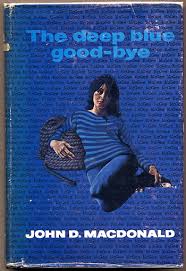
Outer Florida in the 1970s was a frontier where a loner could go to escape and that is what Travis McGee does on his cruiser in the Keys. MacDonald does the regional accents and the class syntax well, but it just goes on, and on and on and on. The characters are differentiated. The locale is brought to life. All that is true.
But it proceeds by endless exposition, like a textbook. There are pages and pages of exposition. Page and page. It is exhausting without forward progress, like listening to a non-stop motor-mouth. One does nothing but grows tired.
I gave up at the twenty percent mark according to the Kindle. If I have not suspended disbelief by that time with a book and entered into its world, I do not press on. There is no honour in the hollow achievement of finishing something I would rather not have started.
A screenwriter would be needed to pull it apart and give it some life. Even the scenes where Travis is questioning witnesses read like depositions rather than dialogue.
John D MacDonald has an interesting backstory himself, but knowing it does not make the book any more engaging. He was a Harvard MBA who gave up a corporate career for the typewriter when he had a young family and worked hard at being writer. I admire that, but, well, see above.
’Spaceflight IC 1′ (1965)
IMDB facts: 1 hour and 5 minutes of treacle time, rated at 3.9/10 from 219 opinionators
What happens? The Caine Mutiny in miniature. It is 2015 and the tyrannical captain of a space ship provokes a mutiny. He may have been right at the start but once the trouble starts, it spirals.

Let’s back up to beginning.
In this telling instead of waiting for the aliens to come and tell us what a mess we have made of things, the Earthlings figure it out for themselves. To add authority to this dictum, it is delivered as a prologue by a uniformed figure. It looked like a Coast Guard coat, but who knows. We need a military figure, it seems, to tell us things, and he does.
The mission is a combined effort of the USA, UK, and Canada. Strines missed out again.
The response to the unspecified catastrophes is to colonise space where further catastrophes will, no doubt, ensue. Thus Spaceflight Inter-Stellar One is on its a way to an unnamed new world to plant a colony with its crew, about which more in a moment. Fortunately, unlike most other space ships launched from Earth in Sy Fy movies this one does not encounter any meteors. Whew!
The crew consists of four married couples and the journey will take years. If a number of years was mentioned my ears blinked. We pick up the travellers at the end of their first year in space when things seem to be going fine. Happy smiles all around. ‘That won’t last,’ predicted the fraternity brothers from the back row.
In addition to these eight there is a cyborg with a human head in a fishbowl on top of a washing machine (to keep him clean). He is an interesting addition to the crew but adds nothing to the story, since he does not get around much. There are also three children, one each for three of the couples. but none for the captain and his prime mate. Indeed, this seems to be a sore point, since colonies need colonists. The fraternity brothers wondered if weightlessness might have…. They were skeptical about the gobbledegook about artificial gravity.
That the captain is twenty years older than his mate and an ugly brute might figure in the equation, too.
The final crew members are four spares, who are in a cryogenic suspension, perhaps a hangover cure. Occasionally the doctor opens the freezer to have a look at them.
The children are entertained after their school lessons with a holographic clown. A nice element but again not integrated into the story.
Scene set, now is the time to thicken the plot. The doctor has a wife and she gets woozy. Next thing you know he diagnoses her and finds a life-threatening disease of some sort. More gobbledegook follows. He demands that the captain turn back so she can be treated before it is too late.
‘Turn back? No way.’
This crew was screened in every way for this mission including health, genetics, toe nails, personality, etc. This is most elite of A-Teams, remember that. Yet they each wear a label of their assignment, engineer, botany, doctor, educator, mutineer, in case they forget. This after a year.
If her genes lack moral fiber and get sick, better she should die in space before reaching the new world, That is the captain’s line, as he refuses either to turn back or to consult Earth command on his iPhone. (That her child is on board is not brought into the story in any way.)
Much angst is developed and expended. Sometime in all this confusion the doctor’s wife, who does not want to go back anyway since it would queer the new world for her child, commits suicide by watching this film. Grim.
The doctor, now enraged, seizes the captain with the help of some others, but at least one couple remains loyal to the captain. Now he has command but the doctor cannot turn around and go back and he cannot keep El Capitan in the brig forever. ‘Smooth move, not,’ shouted the fraternity brothers.
Most of the crew are deliriously happy at the change because now they can remove their assignment designations from their shirts. Rip! Off they go. Was that what the mutiny was about? Trivial but apparently true.
The captain breaks free and regains control with threats, imprecations, Key Performance Indicators, and managementese. Mutiny, eh! That means the death penalty. He laments that it is impossible to build a scaffold or arm a firing squad. This is a sensitive New Age captain.
Ah, being a leader, he has an idea. Shove the mutinous doctor out the airlock. Oh, but wait, he is the doctor. No bother. Before we murder him, he can defrost the spare doctor to take his place, if we ask nice. Asking nice is not in the captain’s playbook. ‘Do it!’ is in his playbook.
Defrosting in haste is never a good idea, as cooks know, and the second doctor bursts out of his freezer like Boris Karloff, all stiff-legged, maybe he got arthritis in there, with tubes and sensors trailing off him. He blunders into the captain, and since this thawed doctor came out without his Hippocratic Oath, he whacks him but good. End of captain. ‘Why didn’t someone do that an hour ago,’ asked the fraternity brothers? Good question.
This thawed doctor, though strong enough to kill the captain with one blow, is smacked and dies. Body count: three.
The doctor pairs off with the captain’s widow. Spaceflight IC-1 continues with no further communication with Earth. Thank goodness.
There may have been an epilogue from Uniform Man but the remoter cut him off.
There is nothing stellar about spaceship Otranto. Space outside is a moor, a swamp, a blizzard, a creature from the IRS, a void to cut off the players. The players seem to be trying but the script gives them nothing. The doctor emotes. Some others look bored. (Ahem.) The captain seems constipated most of the time. He repeats three or four times that he has absolute authority in case we missed it the first three or four times. Remember someone got paid for writing this script.
The cyborg, the children, the holograph are all interesting but do not move the plot. Likewise at some point when the captain is berating his wife for weaknesses he reveals he is a member of R.U.L.E. Wow! What’s that? Dunno and we never find out what it has to do with anything, though the fraternity brothers taxed both very little grey cells speculating on what the acronym stood for. None of their suggestions is edifying enough to repeat here.
Five Sy Fy films in one night
What is the trick to watching five Sy Fy films in one night? Simple. Do some time travelling with the remoter to select another, and another, etc. I confess to watching none of them from beginning to end, and that was a judgement.
They came to a screen near me in this order.
(1) ’Teenagers from Outer Space’ (1959) 1 hour and 26 catatonic minutes, 3.6 on the IMDB scale from 2637 tweenagers.
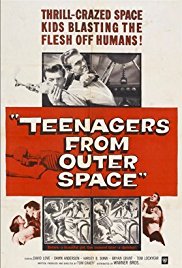 Acne attack!
Acne attack!
I started with this deadly earnest movie in restful black and white. To sum it up, alien boy meets Earth girl and decides not to eradicate all life on her planet. But then he has to decide what to do with the giant lobsters he brought along to devour all life on her planet. The fraternity brothers shouted, ‘Built a barbecue and get cooking!’
While the boy is very boyish, this Jocasta looks forty. Certain lack of verisimilitude there. This viewer lasted for about twenty minutes punctuated with fast forwards, and then the urge to flip over-powered him.
(2) ’It Came from Somewhere Else’ (1988) 1 hour and 29 minutes of Dali time. An astounding 5.7 on the IMDB scale from 100 casters. The producer must have an extended family.
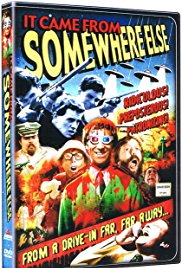
Since ‘It Came from Outer Space’ (1953) is one the hallmarks of the Fifties surge in Sy Fy, I hoped this would be a tribute in some way. Best part was….. [being elsewhere].
It never made it. This viewer lasted ten minutes or so. In the words of one critic: ‘illogical, dopey, stupid, sloppy, strange and incredibly amateurish.’ Too kind, perhaps, but enuf said.
(3) ’Plan 10 from Outer Space’ (1995), 1 hour and 20 minutes at 5.9 on the IMDB scale from 218 ratings.
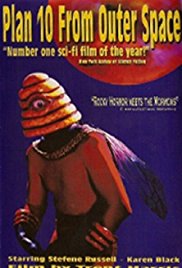
The title is a reference to Ed Wood, Junior’s infamous ‘Plan Nine from Outer Space’ (1959) and it opens with a copywrite infringing excerpt from that schlock, which, all things considered, proved to be more interesting than the student revue that followed. Get it? Ed Wood did it better.
(4) ‘Through the Thorns to the Stars’ (1981) 2 hours and 29 minutes of Dali time. Rated 5.1 from 932 on the IMDB scale. The original title was ‘Cherez ternii k zvyozdam,’ a Russian proverb I am told.
The version I saw had subtitles and I missed quite a bit, what with doing the New York Times crossword and going out to walk the dog for half an hour in the middle. Yet I did not feel like I had missed anything I wanted to see.
The special effects of spaceflight are very good: weightlessness, movement between space craft, the starry void, and the planet Dessa. The story has two threads. One is the strange humanoid creature found on a derelict space ship. She is weird. Looks like someone from an Eastern European death camp of the 1980s with eyes so big I began to suspect some sort of prosthesis. She is enigmatic and perhaps amnesiac.
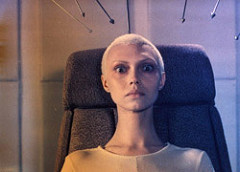
For a good hour everyone wondered if she was human or android. The fraternity brothers offered to give her a physical examination, but to date that offer was not accepted.
She traces back to Dessa, a planet completely despoiled by the pollution of the evil industrialists, read capitalist, to the extent that Russians are called in to help clean it up, now that they have paved over Lake Baikal. On Dessa, because all resources have been depleted, the industrialists sell citizens bottled air, while making plans to take rocket to a brave new world to exploit. Just to make things clear for dim wits like the fraternity brothers, the chief industrialist is played by a dwarf.
When I returned from my outing with Majic, the credits were rolling. The end.
Why did I think of Mikhail Kutuzov. Do little and wait was his motto.
(5) ’The Tower’ (1993) 2 hours of eternity. Over-rated at 4.6 form 467 on the IMDB. N.B. there are several films of this title.

A smart building turns on Paul Reiser and tries to kill him. The fraternity brothers rooted for the building. Paul is immature, slovenly, rude, ungrateful, disorganised, and so a hero who can outwit a door.
Toward the end of this long night of investigation, I began to think of mashing all five of these films together into one.
The Russians land on the Tower where they are seized by It Came From Elsewhere and made to watch Plan 10, repeatedly, in the company of Teenagers from Outer Space and their zits.
‘World Without End’ (1956)
IMDB facts: 1 hour and 20 minutes, rated 5.9/10 from 1417 raters.
A band of four orbit Mars and head for home but the Aussie on the controls is on the wrong side of the road and they fly into the future by more than five hundred years. That is high octane.
They land on a future Earth and set about recreating the society they left behind. They encounter the giant rubber spiders that the fraternity brothers lost.
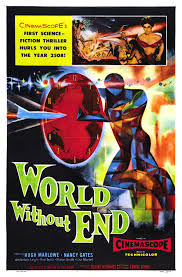 There are no scenes in the movie like that portrayed here. Yes, another misleading lobby card.
There are no scenes in the movie like that portrayed here. Yes, another misleading lobby card.
After some trudging through Bronson Canyon they find the Mole people who are hospitable, and whose society is harmonious, self-sufficient, stable, and dying out for a lack of manly vigor. Note the bronzed Aussie above who cannot keep his shirt on. By the way, he liked time travel so much he did again a year later in ‘The Time Machine.’ Once they get the travel itch, it itches.
The only salvation for the Moles is sunshine. See, very Strine. The leader of the pack is Hugh Marlowe of the pleasing baritone who urges the Moles to go topside and live in the sun. Vitamin D will overcome their endemic anaemia, says Dr Hugh. Stories about skin cancer are Commie disinformation plot to sap the vitality of the Moles.
But topside real estate is owned by mutants because this is a post-apocalyptic society after an atomic war that ‘no one wanted and no one could stop’ intones the Mole historian. There are many more mutants than Moles though the Moles have two eyes and this allows them to have better dress sense with their cloth helmets fitting like a cloche on the men.
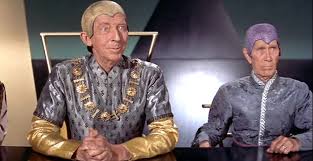 Note the headgear.
Note the headgear.
Mole damsels parade about in 1970’s mini-skirts designed by Alberto Vargas, always ahead of the times.
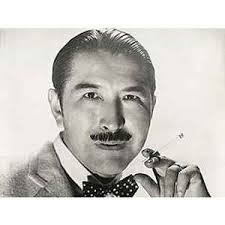 Al Vargas.
Al Vargas.
At the end Hugh has convinced the Moles to go out and fight the Mutants. Ah, war, glorious war. Among the last scenes is one of the pack instructing the now healthy young conscripts on locking and loading. Even the senior Moles, once top side, shed their headwear for sunburn.
In the Cold War context the Moles stand in for those Americans who pretend a normal life is possible and do not sweep under the bed every night for Commies and those soft Europeans who just want to live in peace after two world wars. Bah! What sissies!
In addition to their dress sense the Moles favour hard primary colours that show up best in Cinemascope. The top Mole is a kindly Ray Walston without the antenna, but there are others who mislike these strangers and plot against them. As usual, a scriptwriter is the cause of the strife and it is blamed on a woman.
One of the servants who cleans up after the men was born top side and she seems fetchingly normal, but nothing comes of this realisation. When a bazooka can be made, though how remains a mystery since the Moles have no metal, who needs words. Blast them! They blast them, and the survivors live for a while after, as humanity starts long term preparation for another Armageddon.
It may seem ironic today but none of that was intended at the time.
One oddity is that early on when the crew fails to respond to signals from Earth, we see the wife of one of them waiting with two children. She is worried and distressed. In the same room the press briefing comes to a close. And the journalists respect her privacy and let her leave the room unmolested. Fiction, indeed. Polite, considerate, tactful journos. In this respect the scriptwriter gets full marks for creative imagination.
‘Tobor the Great’ (1954)
It weighs in at 1 hour and 17 minutes of Dali time with a score of 5.2/10 from 476 of the demographic.
The schizophrenia in the production is indicated in the lobby card reproduced below.
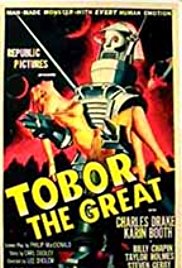 The usual misleading lobby card.
The usual misleading lobby card.
Is it a creature feature. the creature being the robot, or is a kiddie feature? The lobby card draws the creature fans, but the film is more for ages 7-12, making it perfect for the fraternity brothers. It features a precocious and tiresome boy know-it-all. At no time does the robot scoop up a babe. ‘Our client is innocent!’ declared the fraternity brothers from the sofa. There is far more brat than babe in slow moving ooze.
Mr Handsome is Charles Drake, one time sheriff of Sand Rock Arizona where ‘It Came from Outer Space’ in 1953. He must have moved on and gone to grad school in the intervening year to become a scientist in this gig.
It has a thick Cold War patina because ‘the enemy’ is out to get Tobor. The party chiefs have ruled and they must be obeyed or else, exile to New Jersey!
‘Tobor’ is, yes, bright eyes, ‘Robot’ spelled backwards. Toby is a bot but the gossip on the street-web is that someone made a stencil to spell R o b o t for a title card but sprayed it wrong way around and there was no budget, not even in those expansive Ike years, to do it again and so Tobor was christened. There is an explanation of the name in the film, nor of the sobriquet ‘the Great’ except that Robot is mighty big.
The Prof and Sheriff Drake want Tobor to ride rocket into space rather than human monkeys because of the dangers, and the unfunded pension plans. Hmm, that makes sense. Two problems that no one notices: Tobor is a giant at 9 feet tall and weighs as much as a four sumo wrestlers. He will not fit into a rocket capsule! He barely fits into Rhode Island.
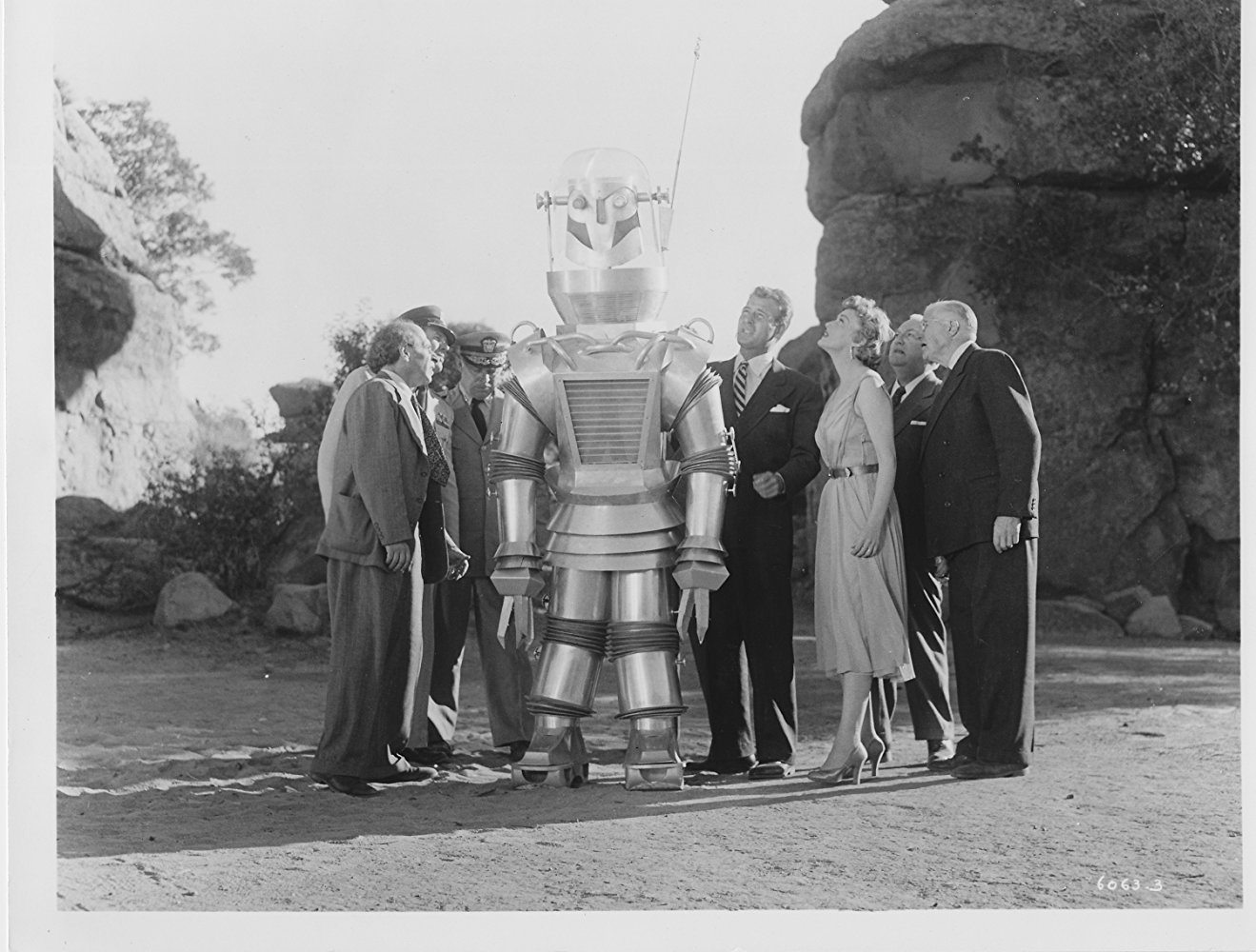 Tobor the Big
Tobor the Big
In addition, the Prof has endowed Tobor with emotions be inserting a sponge in his brain box. Hmm, just the thing for space flight, a moody, home-sick, lonely scrap heap.
Just to ensure things go wrong, the Prof has also called a press conference proudly to demonstrate his bot. He might have done this to embarrass the rocket men into using Toby and not more pilots but then he asks the journalists to keep Toby secret. Sure. Tell the press all and then say, pretty please, do not use it. They broadcast all details immediately to make the job of THE ENEMY easier.
The brat plays with Toby, while the adults are Einstein-napping, and nearly destroys the house. The adults declare the brat to be a genius. Hands up all parents who would react that way. ….. Thought so.
The Enemy is led by Istvan Gyergyay better known, if known at all, as Steven Geray. Like Drake, Geray did much duty in B Land with that accent he made a perfect Commie in more than one feature, with or without a creature. He was born in the Ukraine to Magyar parents when the Hapsburgs held sway
Mr Pomfritt is there, as a journalist, before he went into teaching Dobie, who blabs all. He is a B Sy Fy stalwart. But he went straight after his malfeasance in ‘The Man from Planet X’ (1951).
‘Plan 9 from Outer Space’ (1959)
Running time 1 hour and 19 minutes of Dali time, rated at 4.0/10 from 31,671 time wasters.
Conceived, written, directed, produced, and loved by Ed Wood, Jr. Because it is excruciatingly bad, it has attracted a following as witnessed by the extraordinary number of votes on the IMDb. This for a movie without a theatrical release.
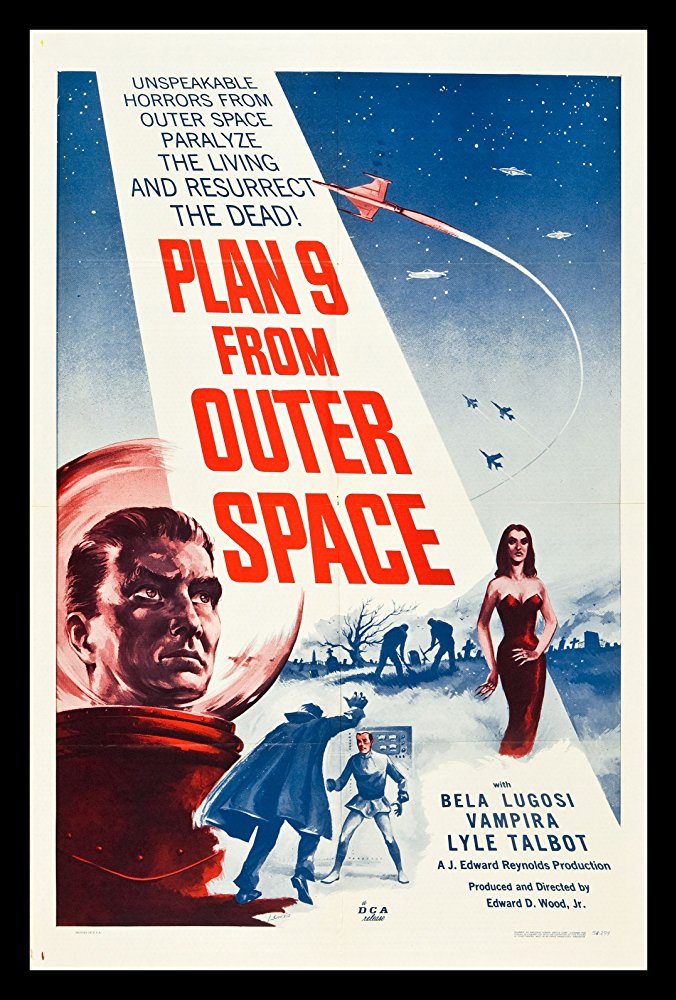 DVD cover.
DVD cover.
Leaving that reputation aside for the moment, here is the set-up. The aliens have tried eight times to communicate with Earthlings. Each attempt has failed. Even when contact is established Earthings simply deny the reality of flying saucers and aliens despite the evidence in front of their eyes. Hmm. That has a contemporary ring. Climate change deniers, anti-vaxxers, Tony Abbotts, unite!
Using non-Aristotelean logic, the aliens give up on living humans and decide to raise the dead (using John 11:38-44 as a manual) and work with them! Work with them? Yes, to destroy the Earth! Egads, why? Because Earthlings are violent, destructive, hostile, and aggressive.
The aliens declare that the Earthlings will not be satisfied with blowing each other up but as technology develops they will start blowing up other worlds. Does that sound like GOP foreign policy? I could not possibly say. That aliens have come to stop Earthlings from destroying the Earth, the solar system, the galaxy, or the universe is a theme in Sy Fy. Wonder why?
Since Earthlings will not negotiate, it is time for the final solution: Plan 9. Vampires provide the creatures for this feature in the dark and misty graveyard where much of the film is set. Though some scenes switch, inexplicably, between day and night and back. Is this post-modernism at work, refusing to privilege continuity!
The flying saucer makes little effort to conceal itself relying for concealment on the delusions that explain the Republican Party today.
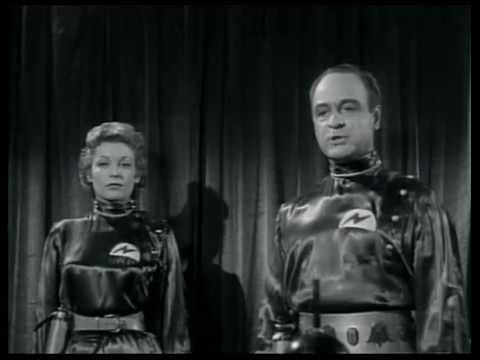 First they iron the shirts and then shine them.
First they iron the shirts and then shine them.
These technologically superior aliens in shiny sateen rigs are defeated by a couple of muscle men who are violent, destructive, hostile, and aggressive, in other words, typical Earthlings. That’ll show ‘em to call us names!
But it ends on a note of caution that they, the aliens, will be back and we have to be ready for them. What does that mean, ready? When they say Earthlings know nothing but violence, just blast them. That works. We’re already NRA-ready!
The production is amateurish. The cardboard walls shake when someone touches them. The flying saucer is sometimes called a cigar (and later it is lit) but it is always shown as what it was, a spinning top. The acting is painful to watch as the players struggle to remember their lines and deliver then slowly with no inflection. The sets are empty, e.g., the cockpit of the passenger aircraft shown twice is two folding chairs, confirming some perceptions of American Airlines.
There are voiceovers that are mawkish and confusing. It is introduced and concluded by a reincarnation of Charles Fort, the favourite author of the fraternity brothers.
Of the cast only Gregory Walcott seems to have had a film career, mostly in television, especially westerns when they were the fashion.
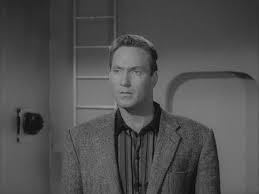 Gregory Walcott
Gregory Walcott
Perhaps his North Carolina accent made producers think he was from the west. West, south, there is no difference when viewed from Hollywood.
The gossip on the web is that Ed Wood started this project as a biography of Bela Lugosi, who figures in about two minutes of the film, and then Lugosi died. Had he seen the rushes? Nothing stopped Ed Wood. He hired his wife’s doctor to stand-in for Lugosi hiding behind the cloak held to his face.
 Is there a doctor in the cape? Yes.
Is there a doctor in the cape? Yes.
That the good doctor was a foot taller than Lugosi with a different colour of hair was ignored. For all of this and more see ‘Ed Wood’ (1994), a biopic
‘The Killings at Outpost Zeta’ (1980)
It runs 1 hour and 32 minutes of Dali time, scored 4.4/10 from 212 friends and relatives of the producer on the IMDB.
Outpost Zeta is a crucial toehold in a vital part of the galaxy. OK. The original garrison went off the air. A rescue mission went in, and it, too, went silent. Then a second. Still nothing. Gulp! Whatever is going on at Zeta, it is not good.
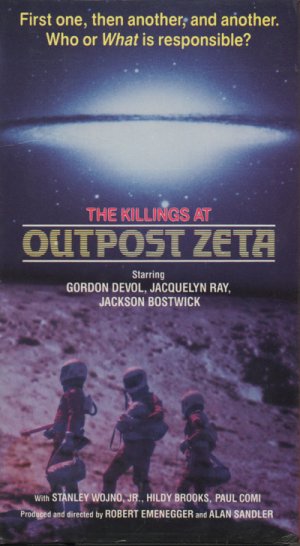 DVD cover.
DVD cover.
A third rescue team of volunteers is assembled, who then dutifully make last wills and testaments. That is a sobering beginning to this low budget creature feature. They are five in number or is it six. They are slain one by one. No wonder, to defend themselves from the unknown and unseen menace they have caulking guns! Still less do they wear any body armour or space suits. The tip jar did not run to such accoutrements but the local hardware store had caulking guns on special.
When arriving at Zeta, they find a space buoy with a message from one of the benighted rescue teams warning them off. Needless to say, this warning is disregarded and they land.
Mercifully we get no backstory for these volunteers. One pales to think what this screen writer would have done with that. Mawkish, adolescent, trite, these are the words the come to mind. Yet none of them strikes this viewer as the volunteering type, pursed lips or not. They are too young to be fatalistic. They are so unlined and unwrinkled, do they have the experience and cool heads to survive where others have, evidently, not.
The squeamish medical doctor is a woman and there is not one demeaning, derogatory, or sexist remark from the Sensitive New Age Soon-to-be-Dead Men. There is also a woman scientist who squawks about the hindrance of security. Yes, one would belittle security after eighteen mysterious deaths. Sure. She is the first to go, and ‘Good riddance!’ shouted the fraternity brothers.
The team does show interest in this strange and alien world. This fact is worth noting because in many B Sy Fy entries the explorers of new worlds show no interest in the new world. These six do. There are a couple of other things to like mentioned below.
The acting is pursed lips, furrowed brows, open-mouthed stares, and many blank looks. The directing is leaden. The production values are homemade. We get a few creature’s eye view that lets the air out of the mystery too early. There is also much heavy breathing. Much.
But the surface of Zeta is eerie and forbidding with an orange filter on the lens and I got to like their red jumps suits and visored white crash helmets. I liked the landscape because it did look strange, unlike so many of these Z movies where the alien world is the producer’s backyard, and looks it. I liked the visored helmets because they were used, not opened for close-ups. It put distance between the viewer and the players with some verisimilitude. Contrast this latter point to ‘Arrival’ (2016) where the safety mask is removed almost immediately for close-ups thereafter. Such is the ego of actors.
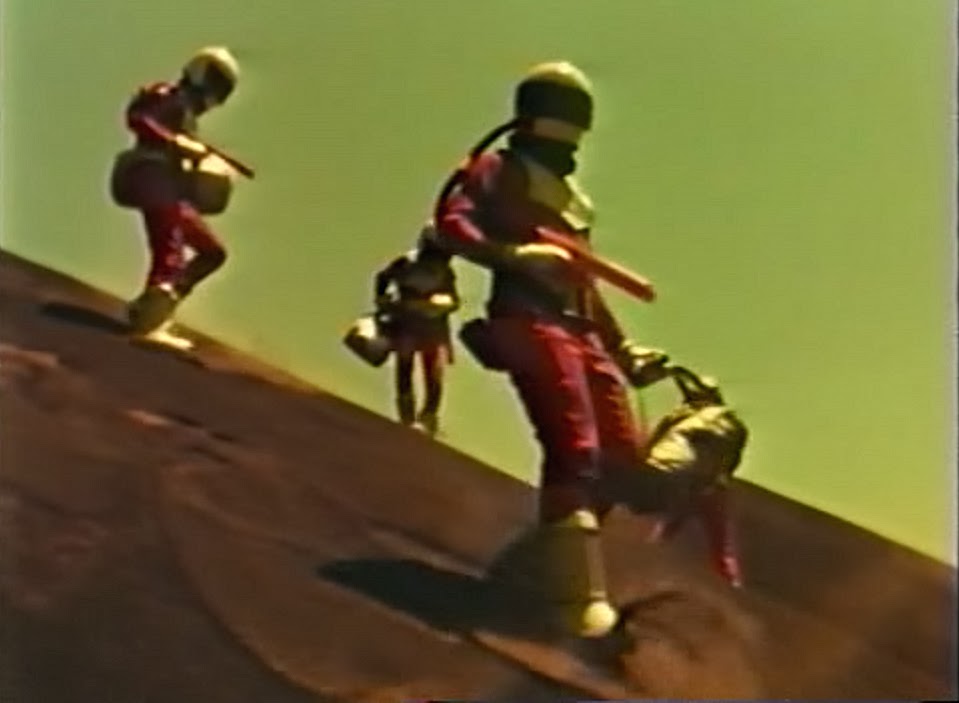 The fashion on Zeta
The fashion on Zeta
Moreover, I liked the creature, some moving hot rocks. Why like murderous hot rocks? Because they are the descendants, surely, of the Horta from ‘The Devil in the Dark’ of Star Trek the Original Series in series one in 1967.
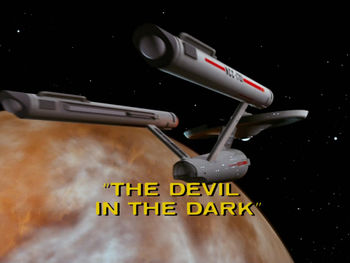
This film, however, lacks the mystery and the compassion of the Star Trek episode. It is played strictly as a hot-rock-creature feature, not an existential rumination on sentience, consciousness, communication, and compassion.
No surprise to see that none of those associated with this film have substantial CVs on the IMDb.
‘Creature with the Atomic Brain’ (1955)
One hour and 9 minutes of running time, scored 5.5/10 from 842 votes.
More a creature feature than Sy Fy, but from a story and screenplay by that Sy Fy journeyman Curt Siodmak and starring the future governor of Hawaii, Richard Denning(er). The director was Edward Cahn.
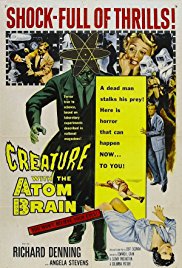
It has a grim opening with a figure walking, dead-eyed, down a darkened, tree-bowered residential street.
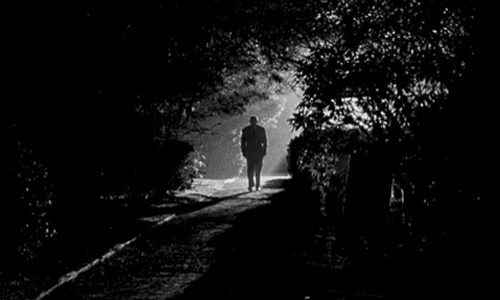
Nice. It gets off to a good start.
A gangster is murdered, then the DA, each time the murderer leaves behind finger prints galore. In case plod misses them, they glow in the dark! The police swing into action, aided by the Governor. Wait! The finger prints trace back in each case to a dead man!
Yes, there is mad scientist with plenty of Bunsen burners at work, implanting electrodes into the brains of recently dead men. Being a sexist he does not body snatch dead woman and give them equal employment opportunity as criminal zombies. He powers the electrodes with radium, hence the word ‘atomic’ in the title, but the creatures are multiple not singular. Since the scientist speaks with a German accent, IMDB reviewers assume he is a Nazi, but there is nothing in the film to support that interpretation apart from the accent. In fact, the actor is Gregory Gaye who was born in Russia and he faked the accent.
His research into brains, electrodes, radium, and espresso has been funded by Frank, a notorious villain who is out to wreak vengeance on criminal business rivals and lawmen. He is as merciless as Ming. In fact, the mad scientists wants to quit but… well, research grant KPIs are KPIs
We do not get to see the body snatching but do get a look at the lead-lined laboratory, lit by Bunsen burners, Bad Frank and Mad Scientist have to crawl through some (unexplained) plastic wrap. It was an unusual effect, but there no point to it, i.e., unless in 1955 plastic shields radium. They crawl through it once and we see it four times. In case we missed it the first three times.
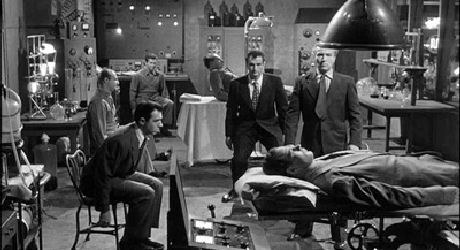 Inventory of the dead.
Inventory of the dead.
Denning goes around thinking, rather than kicking in doors, and is pleasant and polite, so different from current Hollywood Hop-Heads who yell, stomp, and sulk. He enjoys a normal home life with homemaker wife.
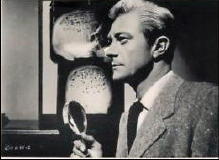 Denning thinking.
Denning thinking.
She is the Donna Reed stereotype of the time and place but perhaps it is more honest than those Sy Fy films of the period that include a lady scientist and then thereafter belittle her and limit her actions to serving coffee and treat her as an object fo the men to fight over.
There is also pathos when one of the avuncular police officers is murdered, and who yet in death helps to undo Big Bad Frank.
Speaking of the stereotypes of the time and place. The army and police are presented as responsive, competent, diligent, dutiful… Well, it is a work of fiction. Where are the lazy coffee drinkers, the petty martinets who will not move without a written presidential order, the oh-hummers who are bored by the end of the world, the corporate underminers? No, the forces of order are not always presented in that way in creature features of the time. In ‘Not of This Earth’ (1957) the local police are lazy, incompetent, heedless, and unresponsive. That seemed more likely to this jaded viewer.
Many zombie movies, and this is the sub-class for this one, made during the Cold War were thinly disguised references to communism. It is easy to see how that can work. Yet in this case I did not get that impression. There is no greater purpose in the film than a few twists and turns to entertain an audience.
Cahn turned out B features ten or more a year with titles like ‘It! Terror from Beyond Space’ (1958), ‘Zombies of Mora Tau’ (1957). ‘The She-Creature’ (1956), ‘Voodoo Woman’ (1957), ‘Dragstrip Girl’ (1957), ‘Invasion of the Saucer Men’ (1957), ‘Cures of the Faceless Man’ (1958), ‘Invisible Invaders’ (1959), and more. What a CV.
